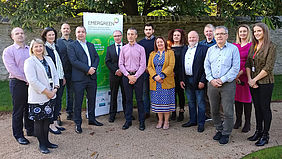Another project participating in theARCTIC PACER clustering project is EMERGREEN, or Emerging Technologies for Greener Communities, funded by Northern Periphery and Arctic Programme 2014-2020.
ERNACT, Donegal County Council and the National University of Ireland in Galway (Ireland), Derry City and Strabane District Council (Northern Ireland), the Association of Local Authorities Västernorrland (Sweden) and the Environment Agency (Faroe Islands) are working together since October 2018 to develop new innovative models for participative, user-centred, quality and sustainable public services aiming greener communities in remote areas.
After following an assessment of the potential technologies available in the partner regions, the partnership are in the process of developing and testing a series of technologies including conversational chatbots making use of Artificial Intelligence for zero waste circular management and green growth advisory services, crowdsourced digital apps for marine coastal erosion management, eParticipatory tools for intelligent green participation and data storytelling to raise awareness of green energies.
“We consider that these experiences, in addition to the services that are under development in the EMERGREEN project at the moment, are observed as a relevant input when defining the new solutions for the ARCTIC PACER complex use cases”, explains Jose Manuel San Emeterio, ARCTIC PACER Project Leader.
About the report on relevant Technologies, Methods and Systems
The report was used by the partners in the EMERGREEN project to identify and assess those experiences available in the participant regions. Rather than starting from scratch, the idea was to maximise the existing knowledge and expertise in the regions to address the development of the planned green growth public services in the project. The specific fields of application relate to waste management and renewable energy and energy saving. Next, it pulls together experiences related to sustainability education and learning. It also includes non-specific service areas by including existing experiences pertaining to and driven by the citizen engagement with innovative methods and a wide exploratory inventory of different technologies or methods with citizen participation in mind.
“The report was a valuable asset for partners when defining their services. It helped to the co-design process by following a practical approach on what could be developed based on successful experiences and existing knowledge in the partnership”, adds Jose Manuel San Emeterio.

